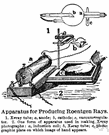roentgen
Also found in: Thesaurus, Medical, Legal, Financial, Acronyms, Encyclopedia, Wikipedia.
Related to roentgen: Roentgen equivalent man, roentgen ray
roent·gen
also rönt·gen (rĕnt′gən, -jən, rŭnt′-)n. Abbr. R or r
A unit of radiation exposure equal to the quantity of ionizing radiation that will produce one electrostatic unit of electricity in one cubic centimeter of dry air at 0°C and standard atmospheric pressure.
[After Wilhelm Conrad Roentgen.]
roent′gen adj.
American Heritage® Dictionary of the English Language, Fifth Edition. Copyright © 2016 by Houghton Mifflin Harcourt Publishing Company. Published by Houghton Mifflin Harcourt Publishing Company. All rights reserved.
Roentgen
orRöntgen
n
(Biography) Wilhelm Konrad (ˈvɪlhɛlm ˈkɔnraːt). 1845–1923, German physicist, who in 1895 discovered X-rays: Nobel prize for physics 1901
roentgen
(ˈrɒntɡən; -tjən; ˈrɛnt-) orröntgen
n
(Units) a unit of dose of electromagnetic radiation equal to the dose that will produce in air a charge of 0.258 × 10–3 coulomb on all ions of one sign, when all the electrons of both signs liberated in a volume of air of mass one kilogram are stopped completely. Symbol: R or r
[C20: named after W. K. Roentgen]
Collins English Dictionary – Complete and Unabridged, 12th Edition 2014 © HarperCollins Publishers 1991, 1994, 1998, 2000, 2003, 2006, 2007, 2009, 2011, 2014
Roent•gen
or Rönt•gen
(ˈrɛnt gən, -dʒən, ˈrʌnt-)n.
1. Wilhelm Konrad, 1845–1923, German physicist.
2. (l.c.) a unit of radiation dosage equal to the amount of ionizing radiation required to produce one electrostatic unit of charge per cubic centimeter of air. Abbr.: r, R
Random House Kernerman Webster's College Dictionary, © 2010 K Dictionaries Ltd. Copyright 2005, 1997, 1991 by Random House, Inc. All rights reserved.
roentgen
A unit of exposure dose of gamma (or X-) radiation. In field dosimetry, one roentgen is essentially equal to one rad.
Dictionary of Military and Associated Terms. US Department of Defense 2005.
ThesaurusAntonymsRelated WordsSynonymsLegend:
Switch to new thesaurus
| Noun | 1. |  roentgen - a unit of radiation exposure; the dose of ionizing radiation that will produce 1 electrostatic unit of electricity in 1 cc of dry air roentgen - a unit of radiation exposure; the dose of ionizing radiation that will produce 1 electrostatic unit of electricity in 1 cc of dry airradioactivity unit - a measure of radioactivity |
| 2. |  Roentgen - German physicist who discovered x-rays and developed roentgenography (1845-1923) Roentgen - German physicist who discovered x-rays and developed roentgenography (1845-1923) |
Based on WordNet 3.0, Farlex clipart collection. © 2003-2012 Princeton University, Farlex Inc.